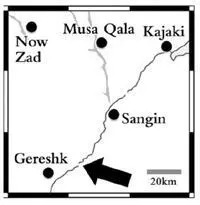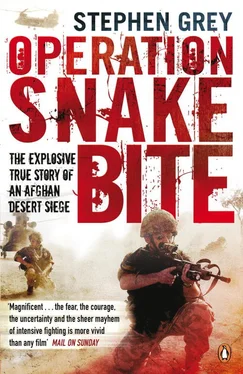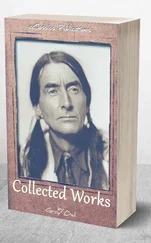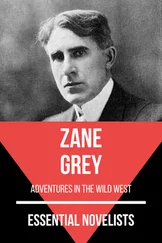From now the Salaam operation was to be handled direct from Kabul, with the assistance of the British. This was not running a secret agent. Salaam was not a secret source. Now he had a satellite phone, Salaam started to talk to everyone. He talked to his British contacts. He called Michael Semple’s team. He talked to contacts at Afghan intelligence and Afghan officials of every variety. But, most of all, this man from a small town who no one really seemed to know stayed in direct and personal touch with the president of Afghanistan himself.
Forward Operating Base Keenan, in the green zone north-east of Gereshk

It was a visit to a base in the green zone that finally clinched Brigadier Mackay’s opinion there had been too much killing: too many pointless ‘clearances’ of Taliban territory and too much emphasis on counting the enemy dead. For the last six days, Forward Operating Base Keenan had been run by the eighty-strong 3 Company of the Coldstream Guards, part of Mackay’s 52 Brigade. The place had been captured during the previous brigade’s push north from Gereshk. The new arrivals thought they would be there for four to six weeks, and then rotate out through Camp Bastion. Mackay told them they would spend six months there.
‘You’re going to be staying here. You need to get to know your ground, to know your enemy and you’ve got to get to know your population.’
The Guardsmen took a look at the bare interior of the base. The previous unit here, A Company of the 2 Mercians, had been living out of their bergens (rucksacks) and day sacks, and with nothing else there except some walls made of Hesco Bastion, the mud-filled wire baskets that had become the instant defensive ramparts on British and American bases across Iraq and Afghanistan. They looked shocked. One turned round: ‘But, sir, there is no population!’
They had all fled; they were living in the desert. ‘And sure enough, when you put your head over the wall, there was no population, Mackay recalled. Looking out of the sangars , what the soldiers called their watchtowers, Mackay could see the ruins of a local school. The Taliban had used it as a firing position and so it had been pounded by the Mercians and then pounded again these last few days. Across the province, the destruction was not hard to see.
Mackay’s brigade was taking over Helmand after a summer of intense violence. Brigadier John Lorimer, his predecessor, had taken the fight into the countryside between the towns along the Helmand River. Putting together large-sized manoeuvre forces, flanked by armour, he attacked the Taliban in their strongholds. But Lorimer did not have the forces to hold every compound or village he captured. The Taliban would creep back in afterwards. He described his operations to journalists as ‘mowing the lawn’
Lorimer’s last operation, code-named ‘Palk Wahel’, had involved a sweep through the green zone between Gereshk and Sangin. It had proved costly – and controversial. In the month of September, seven British soldiers lost their lives, and another was killed the following month as he returned from the same operation.
Within a week of Mackay taking command, the Taliban had shown they were far from cowed. On 15 October, a Danish company commander, Major Anders Storrud, was injured by mortar fire just north of Gereshk and died of his wounds. The same day, the Royal Marines base at FOB Inkerman on the outskirts of Sangin came under full-scale attack.
Four days later, the Mercians were on the helipad at Keenan – ready to fly off – when mortars started landing, and rockets started pounding the base and the checkpoints around. For the Mercians, it was just routine. They did not need an officer or a senior to tell the private soldiers what to do.
Lieutenant Daniel McMahon, a young officer with 3 Company, found the handover daunting. ‘There were us junior officers turning up with no operational experience at all. And there were all these strong, tanned guys talking as if it was the most normal thing in the world to have fire fights, to have rocket-propelled grenades going around, and mortars landing.
The departing soldiers had established this base and others deep into what had been Taliban-controlled countryside. But, Mackay now asked himself, to what purpose unless these places were held over the long term, and by soldiers who got to know the people? The company here – with all its tremendous fighting strength – could, if he chose, be used to push further north and to extend the boundaries of the British-controlled zone. Mackay had seen the way that soldiers like the Mercians had bounced around from one area to another. They had defeated the Taliban every time. But there was a bitter lesson learned from conflicts like the Vietnam war – that a battlefield victory might contribute little or nothing to a strategic success. There were already signs that, over the ground where the previous brigade had won their battles, the Taliban were coming back. Hundreds of the ‘enemy’ had been killed, but that did not seem to make the least difference. In fact, in a Pashtun culture of revenge, killing one man might recruit two others to avenge his death.
Every war was different, every terrain different, and every enemy had different tactics. But this was not an excuse for throwing out the rule book and ignoring all the hard lessons, those learned over decades about how to fight and defeat guerrilla armies.
At the heart of a winning strategy, thought Mackay, was the population. Yes, the insurgents had to be fought and defeated. But the population had to be brought to your side. When your enemy was like the Taliban and wore no uniform and blended seamlessly with the locals, only those locals could be your eyes and ears. They needed to see that you were on their side.
When it arrived in Helmand, the British army proposed to implement what they called the ‘ink-spot theory’, a doctrine used in the Malaya campaign to defeat a Communist revolt. It preached a cautious approach of concentrating effort on creating safe zones free of guerrilla influence from which the ‘ink’ of security and development would spread out gradually across the people and the terrain. People needed to see the benefits of stable government. Only then could they be allies in the war. The way the US army explained this doctrine, the idea was to clear, hold, then build. Drive the enemy from an area. Keep them away. And then start to build something positive for the population, win them over and turn their hearts against the enemy. But for the last year, as the British ranged across Helmand, Afghans had seen plenty of ‘clear’, precious little ‘hold’, and almost no ‘build’.
The war had often been fought instead – despite the best of intentions – as a war against a conventional army, where the simple act of killing the enemy might somehow secure you victory. The trouble for NATO troops in Helmand and across Afghanistan was that there was rarely the number of troops required to hold an area for very long. ‘We’re not really doing counter-insurgency operations yet,’ said one senior British general. ‘We just haven’t got enough people.’
Without actions to win over the population, endless operations to disrupt the enemy or to defend beleaguered government-held towns, as soldiers from the Parachute Regiment had done when they first arrived in Helmand, could be counter-productive. And that raised an uncomfortable question: had blood been shed in vain?
The sight of the destruction the war had brought, despite all the sacrifice, caused real anger among some of those freshly arrived soldiers. One young officer who visited the town of Sangin with Mackay’s brigade spoke from the heart as he described his raw frustration to find that – almost six months after the town had been captured back from the Taliban – almost nothing noticeable had been done to clear the rubble of destruction, and no serious plans were in place for redevelopment, for giving something back to the people. It was not what they believed Britain was in Afghanistan for.
Читать дальше













